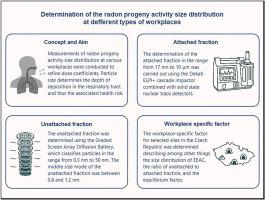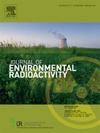不同类型工作场所氡子体活度分布的测定
IF 2.1
3区 环境科学与生态学
Q3 ENVIRONMENTAL SCIENCES
引用次数: 0
摘要
吸入氡及其短寿命子代是自然电离辐射源总有效剂量的最重要因素之一。接触氡子体具有重大的健康风险,主要是因为它与肺癌有确定的联系。剂量系数来自描述氡衰变产物在呼吸道中的行为的生物动力学模型,并结合考虑发射辐射的能量沉积的剂量学模型。鉴于不同工作场所的环境和工作条件的可变性,获得特定地点的气溶胶数据以支持更准确和量身定制的剂量系数计算是有益的。影响有效剂量的关键参数包括平衡等效活度浓度(EEAC)、气溶胶总浓度和放射性气溶胶粒子的大小分布。其他因素,如工作活动、相对湿度和通风类型,会显著影响气溶胶特性,从而影响平衡因子(F)和未附着分数(fp),它们在不同地点之间会有很大差异。本研究使用Dekati ELPI +级联冲击器和梯度屏阵列扩散电池(GSA DB),对几个工作场所的短寿命氡子体的活度分布进行了现场测量。这些测量主要是在自然通风的地下工作场所进行的,包括以前的采矿挖掘和旅游洞穴。为了进行比较,这项研究还包括了一个强制通风的地点——一个处理低放射性废物的设施——和一个受铀矿废石堆氡排放影响的室外地点。本文章由计算机程序翻译,如有差异,请以英文原文为准。

Determination of the radon progeny activity size distribution at different types of workplaces
Inhalation of radon and its short-lived progeny is one of the most significant contributors to the total effective dose from natural sources of ionising radiation. Exposure to radon progeny represents a substantial health risk, primarily due to its established link to lung cancer. Dose coefficients are derived from biokinetic models describing the behaviour of radon decay products in the respiratory tract, combined with dosimetric models that account for energy deposition from emitted radiation.
Given the variability of environmental and working conditions at different workplaces, obtaining site-specific aerosol data to support more accurate and tailored dose coefficient calculations is beneficial. The key parameters influencing effective dose include the equilibrium equivalent activity concentration (EEAC), total aerosol concentration, and the size distribution of radioactive aerosol particles. Additional factors such as work activity, relative humidity, and ventilation type significantly affect aerosol characteristics and, consequently, the equilibrium factor (F) and the unattached fraction (fp), which can vary considerably between sites.
This study presents field measurements of the activity size distribution of short-lived radon progeny at several workplaces, using the Dekati ELPI + cascade impactor and the Graded Screen Array Diffusion Battery (GSA DB). The measurements were conducted primarily at underground workplaces with natural ventilation, including former mining excavations and tourist caves. For comparison, the study also includes one site with forced ventilation—a facility for disposing of low-level radioactive waste—and one outdoor location influenced by radon exhalation from a uranium mining waste rock dump.
求助全文
通过发布文献求助,成功后即可免费获取论文全文。
去求助
来源期刊

Journal of environmental radioactivity
环境科学-环境科学
CiteScore
4.70
自引率
13.00%
发文量
209
审稿时长
73 days
期刊介绍:
The Journal of Environmental Radioactivity provides a coherent international forum for publication of original research or review papers on any aspect of the occurrence of radioactivity in natural systems.
Relevant subject areas range from applications of environmental radionuclides as mechanistic or timescale tracers of natural processes to assessments of the radioecological or radiological effects of ambient radioactivity. Papers deal with naturally occurring nuclides or with those created and released by man through nuclear weapons manufacture and testing, energy production, fuel-cycle technology, etc. Reports on radioactivity in the oceans, sediments, rivers, lakes, groundwaters, soils, atmosphere and all divisions of the biosphere are welcomed, but these should not simply be of a monitoring nature unless the data are particularly innovative.
 求助内容:
求助内容: 应助结果提醒方式:
应助结果提醒方式:


